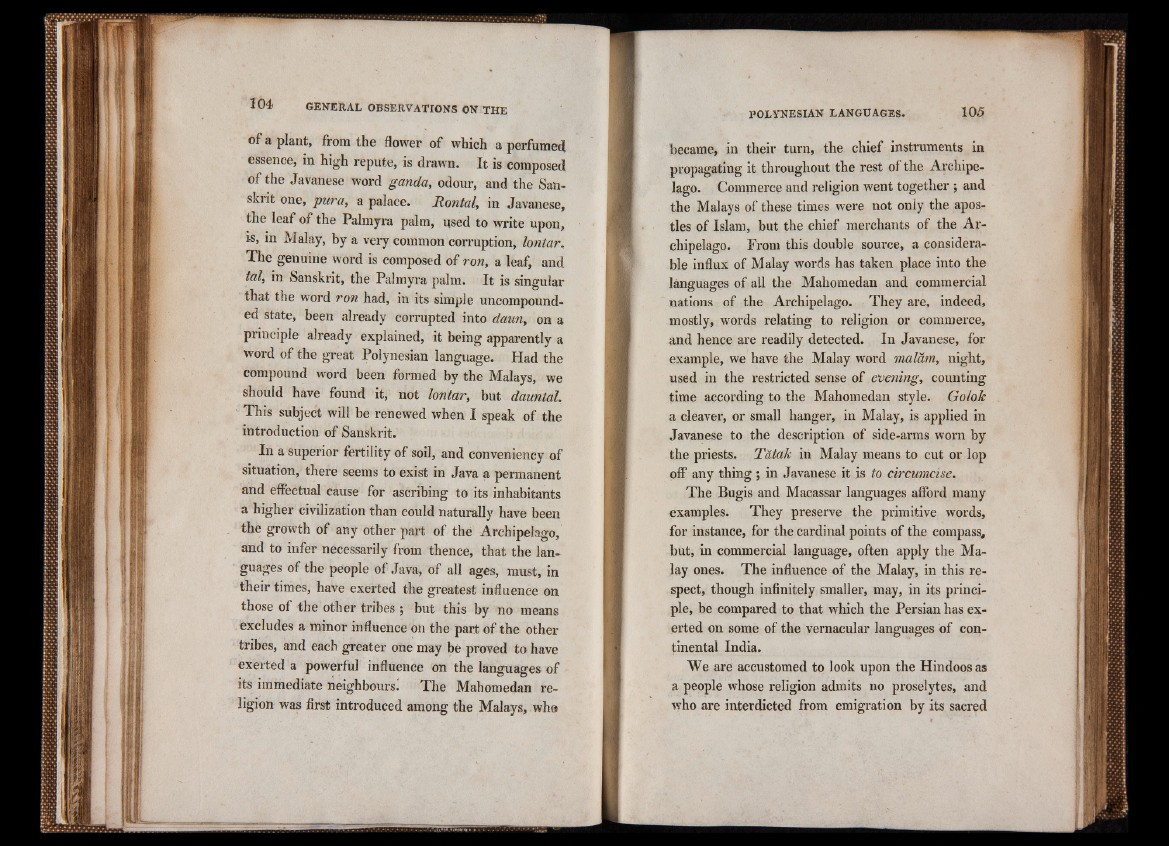
of a plant, from the flower of which a perfumed
essence, in high repute, is drawn. It is composed
of the Javanese word ganda, odour, and the Sanskrit
one, pur a, a palace. Rontal, in Javanese,
the leaf of the Palmyra palm, used to write upon,
is, in Malay, by a very common corruption, lontar.
The genuine word is composed of ron, a leaf, and
tal, in Sanskrit, the Palmyra palm. It is singular
that the word ron had, in its simple uncompounded
state, been already corrupted into daun, on a
principle already explained, it being apparently a
word of the great Polynesian language. Had the
compound word been formed by the Malays, we
should have found it, not lontar, but dauntal.
This subject will be renewed when I speak of the
introduction of Sanskrit.
In a superior fertility of soil, and conveniency of
situation, there seems to exist in Java a permanent
and effectual cause for ascribing to its inhabitants
a higher civilization than could naturally have been
the growth of any other part of the Archipelago,
and to infer necessarily from thence, that the languages
of the people of Java, of all ages, must, in
their times, have exerted the greatest influence on.
those of the other tribes ; but this by no means
excludes a minor influence on the part of the other
tribes, and each greater one may be proved to have
exerted a powerful influence on the languages of
its immediate neighbours. The Mahomedan religion
was first introduced among the Malays, who
became, in their turn, the chief instruments in
propagating it throughout the rest of the Archipelago.
Commerce and religion went together ; and
the Malays of these times were not only the apostles
of Islam, but the chief merchants of the Archipelago.
From this double source, a considerable
influx of Malay words has taken place into the
languages of all the Mahomedan and commercial
nations of the Archipelago. They are, indeed,
mostly, words relating to religion or commerce,
and hence are readily detected. In Javanese, for
example, we have the Malay word maldm, night,
used in the restricted sense of evening, counting
time according to the Mahomedan style. Go/ok
a cleaver, or small hanger, in Malay, is applied in
Javanese to the description of side-arms worn by
the priests. Tatak iri Malay means to cut or lop
off any thing ; in Javanese it js to circumcise.
The Bugis and Macassar languages afford many
examples. They preserve the primitive words,
for instance, for the cardinal points of the compass,
but, in commercial language, often apply the Malay
ones. The influence of the Malay, in this respect,
though infinitely smaller, may, in its principle,
be compared to that which the Persian has exerted
on some of the vernacular languages of continental
India.
We are accustomed to look upon the Hindoos as
a people whose religion admits no proselytes, and
who are interdicted from emigration by its sacred